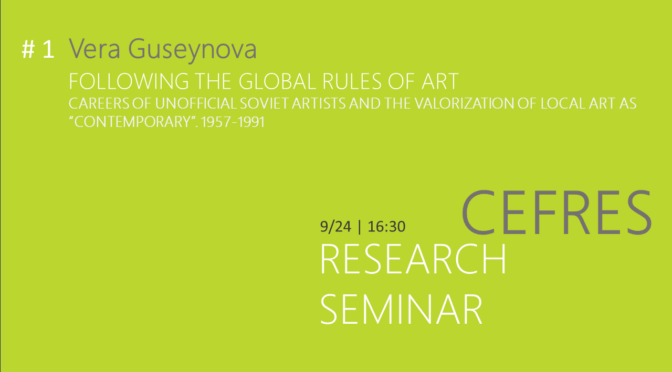Following the Global Rules of Art?
Careers of Unofficial Soviet Artists and the Valorization of Local Art as a “Contemporary”.
1957–1991
1st session of CEFRES in-house seminar
Through the presentation of works in progress, CEFRES’s Seminar aims at raising and discussing issues about methods, approaches or concepts, in a multidisciplinary spirit, allowing everyone to confront her or his own perspectives with the research presented.
Location: CEFRES Library
Date: Tuesday, 24 Septembre, 2024 at 4:30 p.m.
Language: English
Contact / To register: cefres[@]cefres.cz
Vera Guseynova (CEFRES / EHESS)
Chair: Fedra PARKMANN (Institute of Art History, Czech Academy of Sciences / associated at CEFRES)
Abstract
The so-called unofficial Soviet artists gradually opened their art to the West already from the late 1950s. Dreaming of gaining recognition and putting themselves on par with famous international artists, they organized exhibitions which enabled them to enter the space of international art institutions and of the art market. As a result, their art forms the basis of what is now recognized under the label “contemporary Russian art”.
The process of internationalization of unofficial art, which dates back to Soviet times, was largely stimulated by players from outside the USSR. They clandestinely bought and exported these works as souvenirs from the other side of the iron curtain as well as symbols of opposition to the communist regime. In this aspect, it seems that their works were granted value with regards to the specific conditions of political life and not to their artistic quality.
However, the political dimension of this art disappeared together with the collapse of the USSR. How did art, whose interest was largely due to its political connotations, become recognized internationally for its aesthetic value? Who are the key figures of the art world that legitimized and established the artists’ reputations? What role did they play in terms of their contribution to the artists’ careers and their position in the art market? Finally, what was the place of this art as a peripheral artistic phenomenon in the constantly transforming global artistic space, from the late 1950s to the 1990s?
Reference text:
See the complete program of 2024–2025 seminar here.

